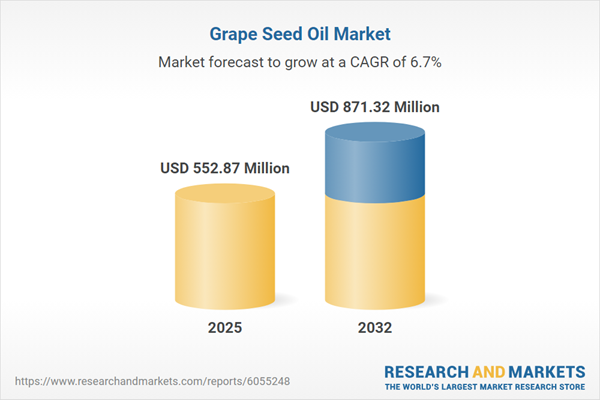Speak directly to the analyst to clarify any post sales queries you may have.
The grape seed oil market is undergoing rapid transformation, driven by changing consumer preferences, technological advancements, and increasing cross-sector applications. This report delivers executive insight into the shifting landscape, empowering senior decision-makers to respond to evolving trends and competitive pressures.
Market Snapshot: Grape Seed Oil Market Growth Overview
The Grape Seed Oil Market grew from USD 519.42 million in 2024 to USD 552.87 million in 2025. It is projected to continue expanding at a compound annual growth rate (CAGR) of 6.67%, reaching USD 871.32 million by 2032. Market expansion is fueled by its widespread adoption in wellness, beauty, and culinary applications, reflecting a broader industry shift toward natural and functional ingredients.
Scope & Segmentation
This research explores the grape seed oil landscape across the following key segments and geographies, underscoring core variables influencing procurement, innovation, and end-use:
- Product: Conventional, Natural
- Usage Type: Cosmetic (Moisturizers, Serums), Culinary (Dressing, Frying, Sautéing), Soap Manufacturing
- Distribution Channel: Offline, Online
- Region: Americas (United States, Canada, Mexico, Brazil, Argentina, Chile, Colombia, Peru), Europe, Middle East & Africa (United Kingdom, Germany, France, Russia, Italy, Spain, Netherlands, Sweden, Poland, Switzerland, United Arab Emirates, Saudi Arabia, Qatar, Turkey, Israel, South Africa, Nigeria, Egypt, Kenya), Asia-Pacific (China, India, Japan, Australia, South Korea, Indonesia, Thailand, Malaysia, Singapore, Taiwan)
- Key Players: Alvinesa Natural Ingredients, Aromex Industry, Avril Supermarché Santé, Borges Agricultural & Industrial Edible Oil, Botanic Innovations LLC, ConnOils LLC, Food & Vine Inc., Gustav Heess Oleochemische Erzeugnisse GmbH, Henry Lamotte Oils, Indulgeo Essentials, Jan K. Overweel Limited, La Tourangelle Inc., NOW Health Group Inc., Oilseeds International Ltd., Oleificio Salvadori, Olitalia S.R.L., Parchem fine & specialty chemicals, Pietro Coricelli S.p.A., Pompeian, Salute Santé, SOPHIM IBERIA S.L., Tampieri spa, The Mountain Rose Herbs, VedaOils, Weleda AG, Émile Noël
- Technologies and Trends: Supercritical CO₂ extraction, enzyme-assisted processes, advanced cold-press facilities, blockchain-enabled traceability, circular economy models
Key Takeaways: Strategic Insights for Decision-Makers
- Consumer demand for clean-label and natural oils is driving rapid adoption of advanced extraction and traceability systems within the industry.
- Flexible production capabilities and collaboration with raw material suppliers give market leaders an edge in responding to evolving beauty, wellness, and gourmet trends.
- Integrating circular economy principles, such as upcycling grape pomace, enhances sustainability and creates new revenue opportunities for processors and vintners.
- Growth across diverse regional markets depends on localized sourcing strategies, regulatory adaptation, and partnerships with distributors in both offline and online channels.
- Digital platforms and data-driven logistics enable companies to strengthen brand trust by communicating provenance and supporting omnichannel retail expansion.
Tariff Impact
The introduction of revised United States tariffs in 2025 has changed sourcing and pricing strategies for imported grape seed oil. Companies are diversifying supply networks, with some domestic processors benefiting from increased opportunities, while others are investing in cost management and risk mitigation solutions. These measures are also prompting supply chain innovation and deeper collaboration between growers and processors to sustain competitive positioning.
Methodology & Data Sources
This report integrates findings from primary interviews, industry surveys, and secondary desk research to ensure data accuracy. Quantitative insights are validated against trade databases, with advanced analytics applied to segment and forecast market performance. Comprehensive assessments—including SWOT and PESTEL analyses—support the actionable intelligence provided.
Why This Report Matters
- Delivers a comprehensive market view for executives seeking strategic clarity on grape seed oil demand drivers and risk factors.
- Supports investment decisions by mapping regional growth patterns, competitive movements, and emerging technology adoption.
- Enables procurement, innovation, and business development teams to benchmark against best practices and industry standards.
Conclusion
Grape seed oil is positioned for sustained expansion across wellness, beauty, and food industries. Senior decision-makers can leverage these in-depth insights to optimize strategies, enhance brand differentiation, and secure long-term growth in a dynamic global market.
Table of Contents
3. Executive Summary
4. Market Overview
7. Cumulative Impact of Artificial Intelligence 2025
Companies Mentioned
The companies profiled in this Grape Seed Oil market report include:- Alvinesa Natural Ingredients
- Aromex Industry
- Avril Supermarché Santé
- Borges Agricultural & Industrial Edible Oil
- Botanic Innovations, LLC
- ConnOils LLC
- Food & Vine, Inc.
- Gustav Heess Oleochemische Erzeugnisse GmbH
- Henry Lamotte Oils
- Indulgeo Essentials
- Jan K. Overweel Limited
- La Tourangelle, Inc.
- NOW Health Group, Inc.
- Oilseeds International Ltd.
- Oleificio Salvadori
- Olitalia S.R.L.
- Parchem fine & specialty chemicals
- Pietro Coricelli S.p.A.
- Pompeian
- Salute Santé
- SOPHIM IBERIA S.L.
- Tampieri spa
- The Mountain Rose Herbs
- VedaOils
- Weleda AG
- Émile Noël
Table Information
| Report Attribute | Details |
|---|---|
| No. of Pages | 190 |
| Published | November 2025 |
| Forecast Period | 2025 - 2032 |
| Estimated Market Value ( USD | $ 552.87 Million |
| Forecasted Market Value ( USD | $ 871.32 Million |
| Compound Annual Growth Rate | 6.6% |
| Regions Covered | Global |
| No. of Companies Mentioned | 27 |









